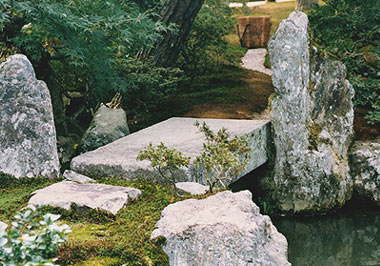Lit.
bridge-anchoring stones. The stones placed at the four corners of a stone
bridge ishibashi Ξ΄. Also called the hashizoe-ishi ΄YΞ,
hashibiki-ishi ΄ψΞ, hashiuke-ishi ΄σΞ, and tamoto-ishi
εΤΞ, these four stones add visual bulk and balance to a bridge and help support
the bank on which the bridge rests. To avoid symmetry, small stones are
balanced with large, low with high. In the Muromachi period, one or two
low stones were employed, while in the Momoyama period three higher stones
were used. By the early Edo period variation in stones became common. The
combination of stone bridge and anchoring stones is called hashi-iwagumi
΄Ξg.
|

